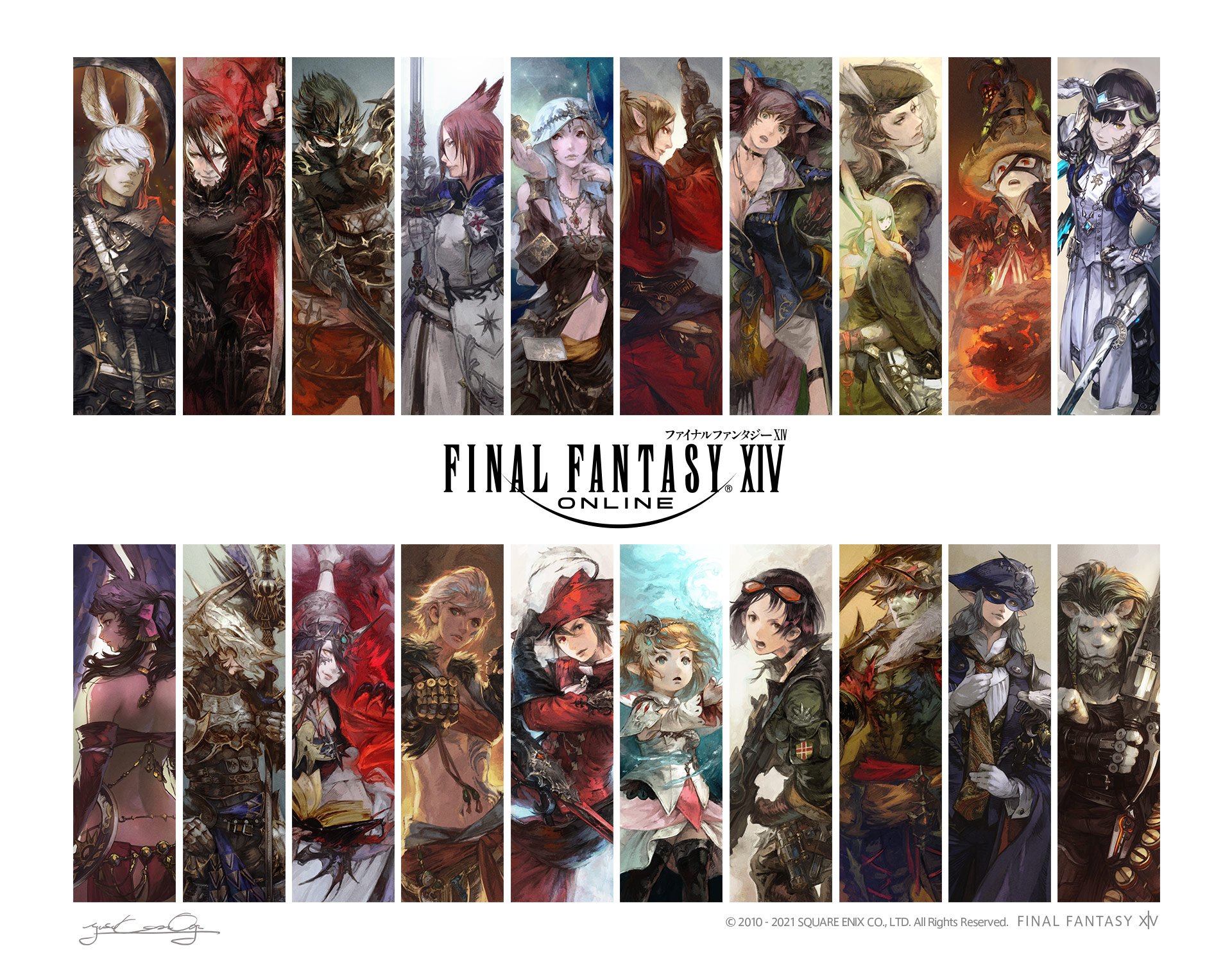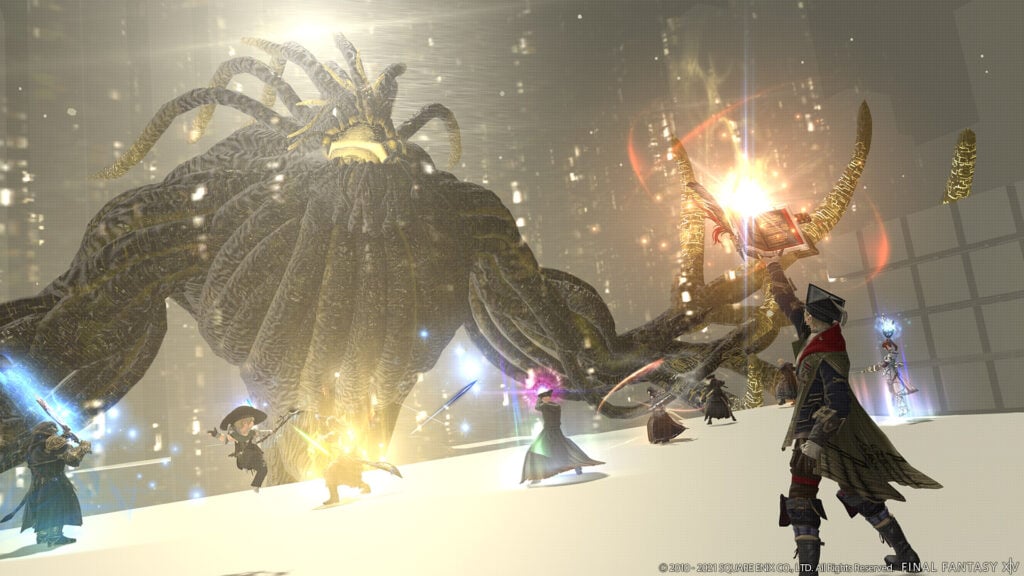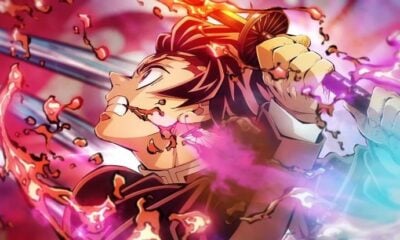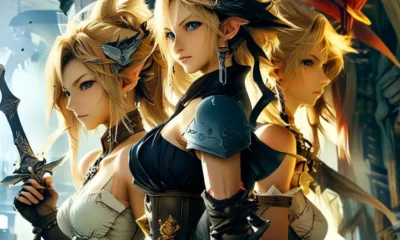Features
How Final Fantasy XIV Defies MMO Tropes
We can always strive to be more than our role.

For a genre that offers us a seemingly vast array of choices and paths, the realm of triple-A MMOs has become a rather limited one in recent years. Sure, there are plenty of classes to pick from with all sorts of exciting rotations to fit a given playstyle, but at the end of the day, players invariably wind up in one of three roles. For all of our unique classes and varied rotations, we are unavoidably homogenized into the MMO’s “Holy Trinity”: Tanks, healers, and damage-dealers (often referred to as DPS).
At the risk of sounding like a “back in my day” curmudgeon, it hasn’t always been this way. The Tank, Healer, and DPS trifecta trend seemed to solidify itself over World of Warcraft’s tenure. With the game’s player numbers being what they were, many larger MMOs began to follow suit. Heavy-hitters like Elder Scrolls Online, Star Wars: The Old Republic, and even Final Fantasy XIV would all come to gravitate toward the formulaic triple-threat, and a trend had now solidified, for better or worse. Try as they might to dress it up with free-form class building (ESO) or throwbacks to old-school talent trees, the three-role meta had become–and remains–a staple.
But what of World of Warcraft’s progenitors? As much as a decade’s worth of stale Barrens chat would love us to believe otherwise, World of Warcraft was, in fact, not the first MMO. While Blizzard may have taken the crown in 2004, the throne was hardly vacant before their meteoric rise to power. Launched 5 years prior in 1999, a massively successful MMO of a vastly different breed was king; one whose like we have not seen since.

Published by Sony Online Entertainment and helmed by the ambitious team of Steve Clover, Bill Trost, and the sadly late Brad McQuaid, EverQuest serves as a monumental cornerstone of not only the MMO genre but of gaming as a larger medium. To say it broke new ground would be underselling the impact EverQuest left in its wake; they more or less created the template on which every modern MMO has been based to one degree or another. In its time, it was a titan of innovation that saw unprecedented success in a genre that was, until that point, rather niche.
The differences between EverQuest and today’s MMOs could populate a list worthy of its own article, but a major divergence that we’ll be focusing on is class identity and interdependency. Much like modern MMOs, EverQuest featured the Tank/Healer/DPS trio that would populate most groups, but that’s far from where the list stops. In addition to the Trinity, EverQuest hosted a plethora of support and utility classes whose roles were not so rigidly defined.
An Enchanter, for example, was tasked with crowd control. They could charm enemies into being their pets, and if a fight got too large for a tank to handle, they were tasked with mesmerizing the excess mobs into a non-hostile state so that the group would not become overwhelmed. In addition to their crowd control, they were often sought after for their powerful class-specific mana regen buff, Clarity. Their specific utility and contribution to a group was something only an Enchanter could bring; their skillset couldn’t just be swapped out with a Rogue or a Monk. It wasn’t simply another flavor of DPS or Healer, it was a role that served an entirely different function from the Trinity.
And Enchanters were not alone; Bards were a veritable swiss army knife of support functions. Does the group need more survivability? We’ve got songs for armor and resistance buffs. Do the healers need a hand keeping folks topped off between fights? We’ve got regen songs, both health and mana. Take your pick! Do we need more damage output? We’ve got debuff and damage-over-time songs. Wherever a weak spot in the group might be, a Bard could help. Their damage output wasn’t spectacular and their regen songs couldn’t hold a candle to a dedicated healer, but their wide array of support mechanics made everyone’s jobs easier.
Shaman had a slew of buffs, heals, and damaging spells that made them a sort of “jack of all trades” hybrid, Druids could turn themselves and group members into wolves to avoid being attacked by animals or powerful guards of opposing factions, and Necromancers could summon the corpses of fallen allies for easier retrieval of your equipment after death. Everyone had something unique they brought to the table that couldn’t be replicated (well, just about everyone). If your Bard had to leave, it wasn’t as cut-and-dry as “getting another damage dealer.” Replacing an Enchanter with a Monk, for instance, completely altered the flow of combat within a group. Different classes had vastly different synergies, and each class carried a genuine feeling of individuality that has yet to be recaptured.

Contrasted with more modern MMO design, EverQuest was far less streamlined than its contemporaries. Get a group in Star Wars: The Old Republic or World of Warcraft, and every class within a given role can be seamlessly swapped with any other class. A Sniper and a Powertech serve the same function; a Ret Paladin and a Combat Rogue have very little to differentiate themselves in the larger picture of a group. Granted, their rotations are unique and they may have the occasional cooldown that makes them stand apart for short 15 second bursts, but nothing that transcends their role of DPS.
The days of dedicated support and utility roles have seemingly come to a close; MMOs the likes of Rift and Lord of the Rings Online took up EverQuest’s mantle admirably with classes like LotRO’s Captain or Rift’s ambitious free-form talent trees which allowed the mixing and matching of roles at will, but even those more “modern” examples have fallen at the wayside of their streamlined competition.
Now, you may have noticed a distinct lack of discussion about Final Fantasy XIV in this article supposedly about Final Fantasy XIV; we’re pretty deep in the weeds with all this talk of EverQuest and bygone design philosophies. Fret not, dear reader; you didn’t take a wrong turn at the home page. Hydaelyn is just around the corner. We’re in the home stretch, I promise.
Well, almost.

Following a recent mass exodus from World of Warcraft, Square Enix’s Final Fantasy XIV has seen a massive swell in players over the last year, so much so that they had to stop selling the game for a time due to server congestion. Yes, the game was literally too successful following the launch of Endwalker. While numbers are kept private for the most part, it’s somewhat of an open secret that Final Fantasy XIV has claimed the throne as of late. With a new king on the block, it would be all too easy to embrace a contrarian mindset and look with a cynical eye at its conventional MMO archetypes and tropes, but that surface-level simplicity betrays a glimmer of what made EverQuest special all those years ago.
First off, it probably goes without saying at this point that Final Fantasy XIV is a fantastic MMO that is only improving with time. Each expansion brings refined and thoughtful content, a storyline crafted with meticulous care, and a general degree of polish unrivaled in its genre. Looking at its recent success, it’s difficult to argue that its praises are not well deserved. As tempting as it might be to gush about Final Fantasy XIV for the next few paragraphs, a modicum of restraint probably wouldn’t hurt anyone at this point. Right, class design. Focus.
At first glance, it might seem like Final Fantasy XIV has fallen into the same trappings as other modern MMOs with its adherence to the aforementioned MMO Holy Trinity. Where Final Fantasy XIV stands apart is in its subversion of that formula within those traditional roles. Yes, you are going to be a tank, a healer, or a DPS, but with every new expansion, that EverQuest spark flickers ever brighter in Square Enix’s design philosophy. They may not break the overarching conventions of modern MMO roles, but they are doing their utmost to find creative ways for classes (referred to as jobs in Final Fantasy XIV) to contribute outside of their designated roles.
Full disclosure, this was written by a Red Mage main, so do with that information what you will. If you believe that introduces an unfair bias in the following analysis… You may very well be right.

With that in mind, Red Mage is amazing. Aside from the fact that their class gear is impeccably stylish, their rotation is straightforward and has a natural flow that lends itself to that feeling of “getting in rhythm.” While designing a damage class with a satisfying rotation is all well and good, there are two abilities vital to the Red Mage’s kit that make them unique among damage dealers.
The first ability is an innate passive that is core to the Red Mage rotation: Dualcast. This passive allows the Red Mage to cast two spells in quick succession, provided the first spell is not already instant. After casting any spell with a cast timer, Dualcast will proc, making your next spell an instant cast, regardless of how long or short its native cast timer might be. This allows for the rapid-fire of spells that would otherwise have incredibly long wind-ups and offers a great deal of opportunity when paired with the proper spell combinations.
The second ability is where things get interesting. See, Red Mages have an ability called “Verraise” that allows them to resurrect fallen allies, even in combat. Combat resurrections are nothing new to MMOs, but Final Fantasy XIV takes a slightly different approach to the concept. Where World of Warcraft or Star Wars: The Old Republic might give a DPS/Healer the ability to “combat rez”, this is usually a one-time deal that has a lengthy cooldown period.
In Final Fantasy XIV, resurrection spells don’t go on cooldown and can be cast as many times in combat as mana pools will allow. Healing classes all receive some version of the “Raise” spell, but the cast time is lengthy and could potentially risk more casualties if too much time is spent not healing. With casting times ranging from 7-10 seconds, this can be a risky play for a healer. For a Red Mage, however, that near 10 second cast time isn’t quite as daunting. That’s right: Dualcast to the rescue. Provided they cast a quick spell beforehand, Red Mages are in the unique position of having an instant resurrection with no real cooldown period. If a raid group is struggling, a Red Mage could potentially resurrect 5 or 6 players without taxing the healers.
And this is where Final Fantasy XIV subverts the trend. Yes, the Red Mage is a DPS class that is confined to the DPS role within the Trinity, but thanks to the unique nature of their kit, they have the opportunity to transcend that role when the need arises. The presence of a Red Mage offers a group a distinct utility that they can’t get from a Samurai or a Machinist; they have a significant support mechanic that is unique to them.

And the buck doesn’t stop at Red Mage. As expansions introduce new classes, that same spark can be found throughout Final Fantasy XIV’s DNA. The Sage – Endwalker’s new healing class – uses damaging spells as part of their kit to heal their party. They might technically be healers as far as their defined role is concerned, but tendencies from the DPS role have spilled over to give us a class that’s more akin to a hybrid than the other healers. In that same boat is the Gunbreaker; a tank class with an incredibly active DPS-like rotation that makes them feel more like bruisers in comparison to traditional tanks.
With their more recent classes, the roles of the rigidly defined Trinity have started to blur; echoes of the hybrids we saw in EverQuest are all over Final Fantasy XIV. Astrologians don’t just heal, they have class-specific buffs they can apply to group members that enhance their abilities. Dancers, a damage class, have a decent group heal to chip in some mitigation in periods of high burst damage. The list goes on.
The point is that while they may not have the diversity in utility that EverQuest had, Final Fantasy XIV is showing a positive trend in class design. A Red Mage will never be able to heal through a tank-buster, and a Sage will never pull enough DPS to beat an enrage timer without assistance, but they have the tools to help outside of their role. We’ll probably never see the likes of the EverQuest Bard again, the dedicated support/utility role being a casualty of modern MMO design, but hints of that same creative spirit radiate throughout Final Fantasy XIV.
Ironically, Final Fantasy XIV’s foreboding new expansion, Endwalker, could not be further from the truth; their brightest days are most assuredly ahead of them.

-

 Features3 weeks ago
Features3 weeks agoDon’t Watch These 5 Fantasy Anime… Unless You Want to Be Obsessed
-

 Culture3 weeks ago
Culture3 weeks agoMultiplayer Online Gaming Communities Connect Players Across International Borders
-

 Features3 weeks ago
Features3 weeks ago“Even if it’s used a little, it’s fine”: Demon Slayer Star Shrugs Off AI Threat
-

 Features1 week ago
Features1 week agoBest Cross-Platform Games for PC, PS5, Xbox, and Switch
-

 Game Reviews3 weeks ago
Game Reviews3 weeks agoHow Overcooked! 2 Made Ruining Friendships Fun
-

 Guides4 weeks ago
Guides4 weeks agoMaking Gold in WoW: Smart, Steady, and Enjoyable
-

 Features2 weeks ago
Features2 weeks ago8 Video Games That Gradually Get Harder
-

 Game Reviews3 weeks ago
Game Reviews3 weeks agoHow Persona 5 Royal Critiques the Cult of Success
-

 Features1 week ago
Features1 week agoThe End Is Near! Demon Slayer’s Final Arc Trailer Hints at a Battle of Legends
-

 Features2 weeks ago
Features2 weeks agoDon’t Miss This: Tokyo Revengers’ ‘Three Titans’ Arc Is What Fans Have Waited For!
-

 Guides2 weeks ago
Guides2 weeks agoHow to buy games on Steam without a credit card
-

 Game Reviews1 week ago
Game Reviews1 week agoFinal Fantasy VII Rebirth Review: A Worthy Successor?



















